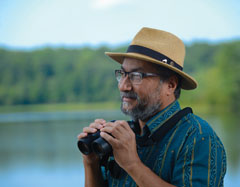July 09, 2018
 In 1993, when Madhusudan Katti was a PhD candidate, he asked Sigma Xi for help. He proposed that the Society’s Grants-in-Aid of Research (GIAR) program give him a grant to help pay for his research on factors that influenced winter survival of migrating birds in southern India.
In 1993, when Madhusudan Katti was a PhD candidate, he asked Sigma Xi for help. He proposed that the Society’s Grants-in-Aid of Research (GIAR) program give him a grant to help pay for his research on factors that influenced winter survival of migrating birds in southern India.
Sigma Xi members gathered later that year to review grant proposals, and picked Katti’s request as one that deserved support.
He doesn’t remember exactly what he used the grant money for—probably equipment—and he doesn’t remember if it was his third or fourth grant. What does stick out in his memory is that receiving the money helped build his confidence in his grant-writing skills early in his career.
Today, Katti is an associate professor at North Carolina State University with a research discipline in ecology. He studies how human actions interact with the success of other species in cities. He was among the Sigma Xi members who gathered this spring to review grant proposals. He wanted to add helpful comments for the students who applied.
“It’s useful to give as much constructive feedback as possible,” Katti said, so the students can develop their own grant-writing skills.
GIAR proposals require students to be precise and to clearly explain why their project stands out in crowded research categories. The program funds less than 20 percent of applications.
“It’s also important to show the broader impacts,” Katti said. Applicants must answer the question: Why should anyone care? It’s a question that researchers are constantly facing, and one that Katti helps to address in his role on the steering committee of the Urban Biodiversity Research and Coordination Network (UrBioNet), a collaborative research network that is studying global urban biodiversity and seeking to increase the public’s involvement with science.